
A section of fairway is irrigated during the winter months at Desert Lakes Golf Course in Alamogordo, N.M. Photo by Darrell J. Pehr
The primary goal of golf course turfgrass management is to achieve ideal aesthetic and playability characteristics, such as uniform density, nice color and high-quality green coverage (9). However, in many cases, natural precipitation alone is insufficient to maintain these standards, making supplemental irrigation necessary (7). The reliance on irrigation has contributed to the U.S. golf industry’s significant water consumption — approximately 2.1 billion gallons per day, or about 0.5% of the total daily U.S. water usage (5).
Since 2005, water usage by U.S. golf courses has decreased by 29%, primarily due to a 12% reduction in the number of golf facilities and a 25% reduction in water applied per acre (7). However, with increasing concerns over water scarcity (4), the golf industry's water consumption has become a potential target for improving water use efficiency.
Precision irrigation is an emerging useful strategy to reduce water consumption by applying irrigation only where, when and in the precise amounts needed. Several empirical studies have shown that precision irrigation significantly improves irrigation water use efficiency on golf courses (10). Moreover, it can reduce operational costs and maintain the aesthetic and playability standards that attract golfers, ultimately leading to higher profits for golf courses (1, 8, 11). Additionally, precision irrigation can preserve soil quality by reducing nutrient loss and conserving soil moisture, as shown by agricultural studies (2, 6).
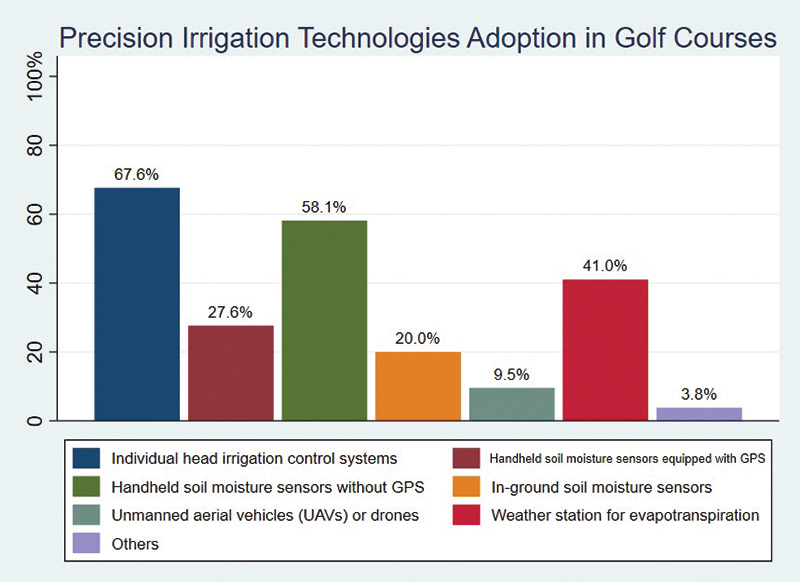
Figure 1. Adoption rate of precision irrigation technologies by golf courses.
Given these benefits, precision irrigation is an appealing solution for reducing water use on golf courses. However, despite advantages, the adoption rates of some new irrigation technologies on golf courses remain low (3, 7). To effectively increase adoption, it is important to understand the barriers and driving forces behind the decision to adopt these technologies.
Research methodology
To explore the factors influencing the adoption of precision irrigation technologies, we conducted an online survey with U.S. golf course superintendents. The survey included questions related to the adoption of various precision irrigation technologies, the driving forces behind their adoption and the barriers that may prevent adoption. A total of 105 golf course superintendents completed the survey, and 82.9% (87 superintendents) reported that they had adopted some form of precision irrigation technology.
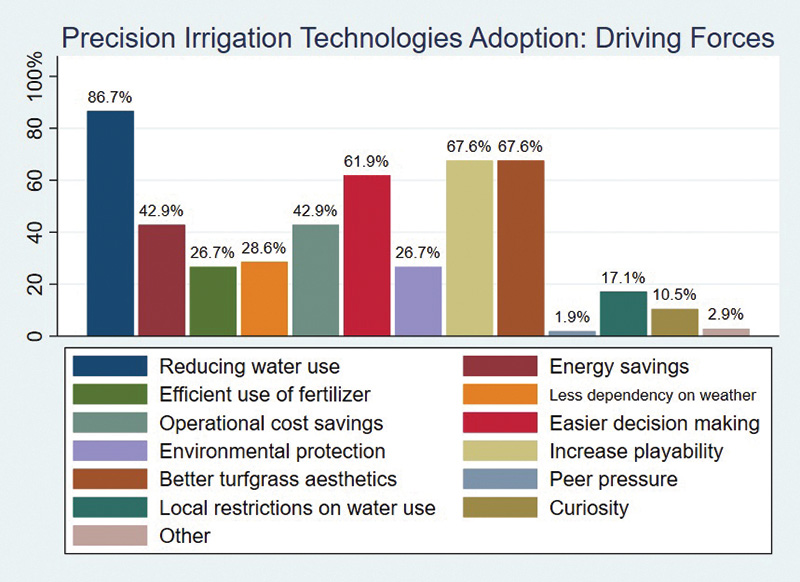
Figure 2. Driving forces of precision irrigation technology adoption.
Findings
Current adoption of precision irrigation technologies
The survey included the adoption of seven categories of precision irrigation technologies: individual head irrigation control systems, handheld soil moisture sensors with and without GPS, in-ground soil moisture sensors, unmanned aerial vehicles (UAVs) or drones, weather stations for evapotranspiration, and other technologies. As shown in Figure 1, the most widely adopted technology was individual head irrigation control systems (67.6%), followed by handheld soil moisture sensors without GPS (58.1%). The least adopted technologies were UAVs (9.5%) and in-ground soil moisture sensors (20.0%).
Driving forces behind adoption
The survey also explored the driving forces behind the adoption of precision irrigation technologies. Overall, the three most influential driving forces for adopting precision irrigation technology are reducing water use (86.7%), improving playability (67.6%) and enhancing turfgrass aesthetics (67.6%) (Figure 2).
For superintendents who had already adopted these technologies, the top three driving forces were reducing water use (88.5%), increasing playability (67.6%) and enhancing turfgrass aesthetics (67.6%). For those who had not yet adopted any technology, the primary motivation was better turfgrass aesthetics (88.9%), followed by reducing water use (77.8%) and increasing playability (66.7%) (Figure 3).
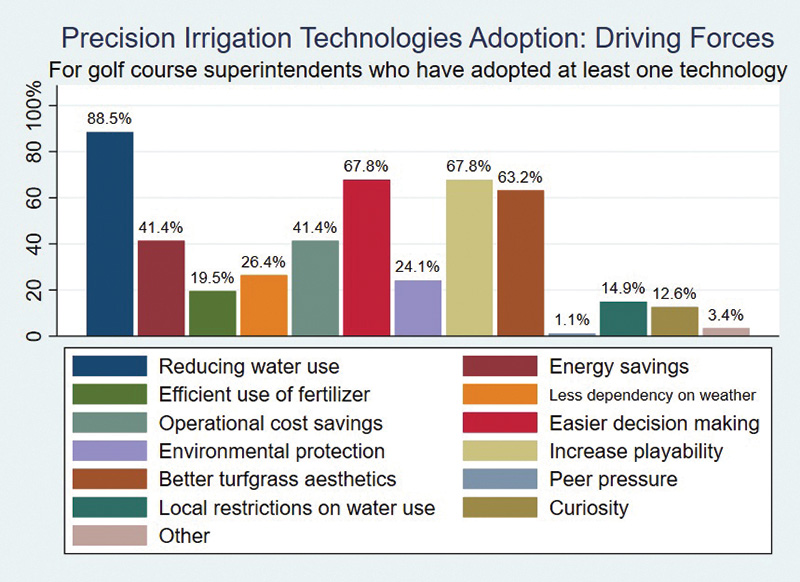
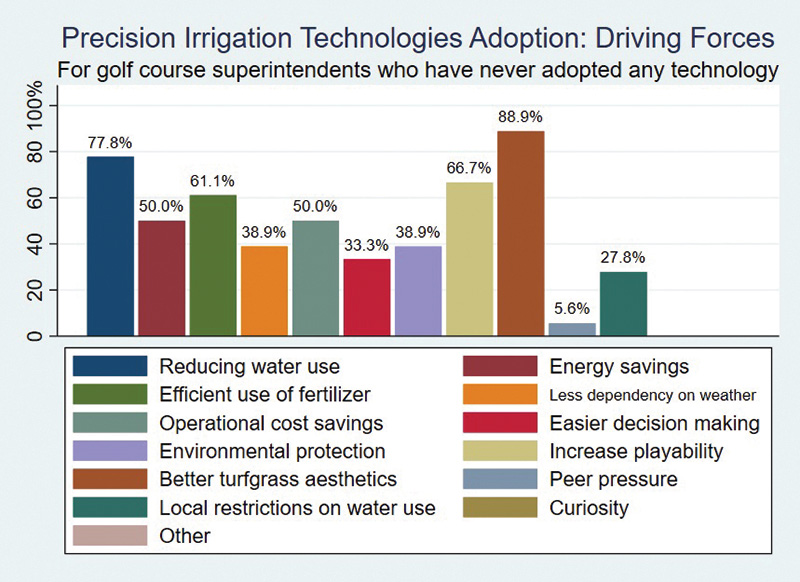
Figure 3. Driving forces of adoption: for superintendents who have adopted some technology (top) and driving forces of adoption: for superintendents who have never adopted any technology (bottom).
Barriers to adoption
The survey identified several barriers to the adoption of precision irrigation technologies. Figure 4 shows that the most significant barrier for both groups was the high initial cost of adoption (77.1%). This suggests that high costs are the primary obstacle not only in the decision to adopt the first precision irrigation technology but also in expanding the use of additional technologies.
For superintendents who had not adopted any technology, the need for approval from higher-level administrators was also a major barrier (83.3%) (Figure 5). This indicates that the decision to adopt precision irrigation may be influenced more by administrative barriers than by the superintendents’ own willingness to adopt.
Information sources for learning about precision irrigation technologies
To better understand how to promote the adoption of precision irrigation technologies, we asked superintendents how they learned about these technologies. Figure 6 illustrates that the most common sources of information were industry associations (67.6%), peer referrals (61.9%) and sales and manufacturer representatives (50.5%). In contrast, public information platforms like social media (16.2%) and search engines (9.5%) were less frequently used, suggesting that industry-based sources are the major channels for learning about precision irrigation technologies.
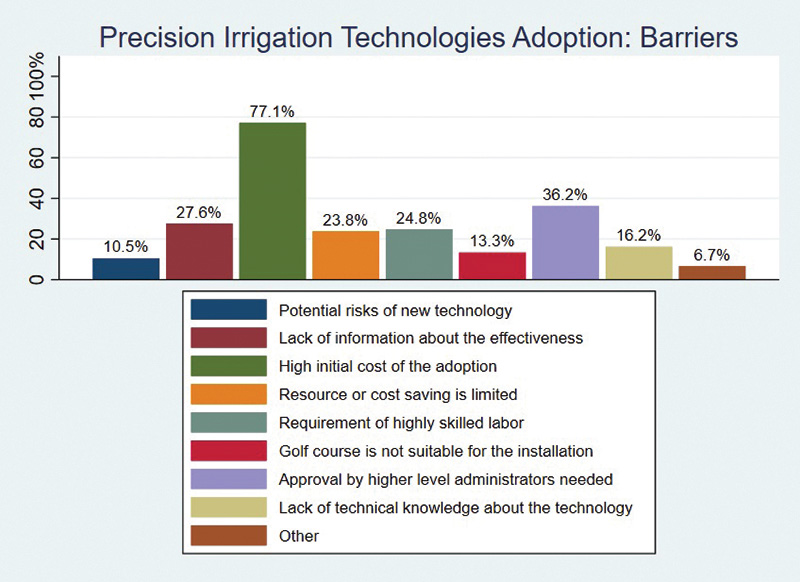
Figure 4. Barriers of precision irrigation technology adoption
Understanding the relationship between adoption decisions and driving forces and barriers to adoption
We used an economic model to analyze how golf course superintendents make decisions about adopting precision irrigation technologies. This model helped us explore the relationship between superintendents' self-reported driving forces, barriers and their actual adoption decisions. Interestingly, while reducing water use was reported as the top driving force, it wasn’t statistically significant in the model. This might be due to a lack of variation for this driving force — most superintendents agreed on its importance. The model showed that superintendents who valued energy savings and easier decision-making were more likely to adopt these technologies. On the other hand, those focused on efficient fertilizer use were less likely to adopt, possibly due to a lack of understanding of how precision irrigation can improve fertilizer efficiency.
When examining barriers to adoption, the model showed that high initial costs, the unsuitability of some courses for new installations and the need for approval from higher-level administrators were significant barriers. Certified golf course superintendents and those with performance-based pay or higher management budgets were more likely to overcome these barriers and adopt precision irrigation technologies.
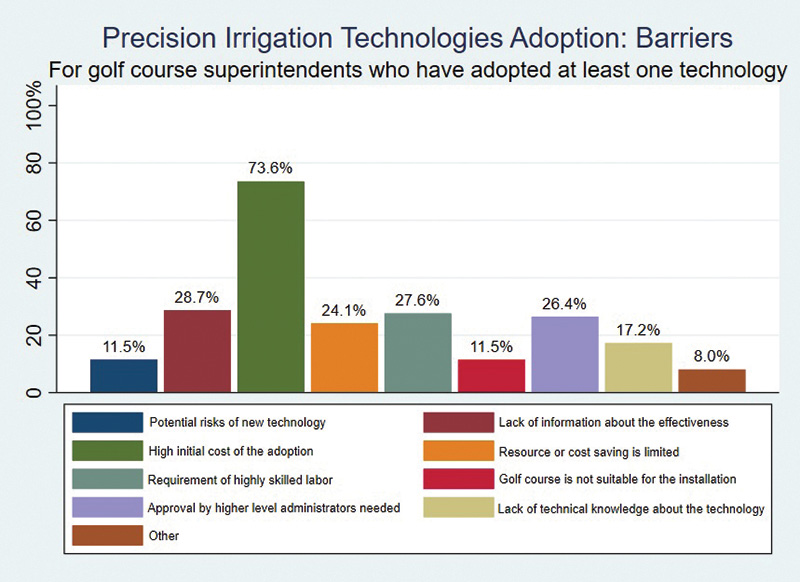
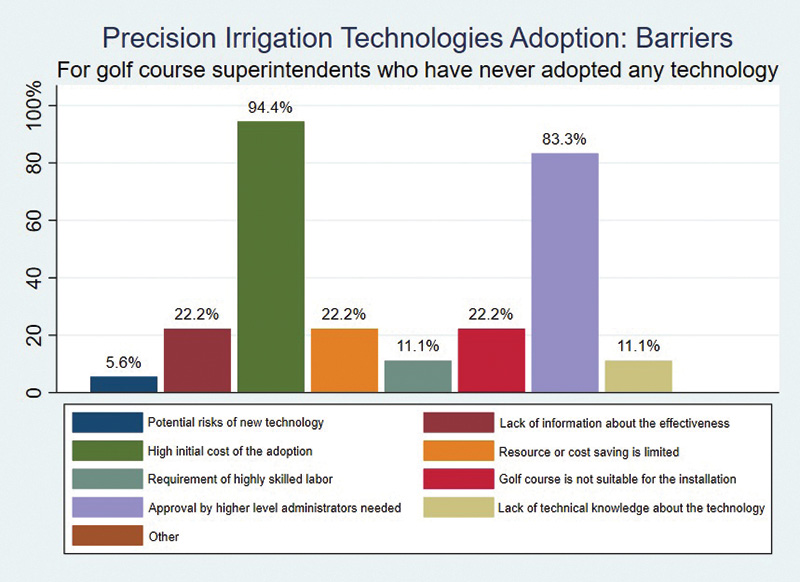
Figure 5. Barriers of adoption for superintendents who have adopted some technology (top) and for superintendents who have never adopted any technology (bottom)
Recommendations
Based on these findings, we propose several strategies to promote the adoption of precision irrigation technologies in the golf industry:
Reducing costs: Manufacturers should explore ways to lower production costs, which could make these technologies more accessible by reducing the high initial investment costs.
Targeted promotion: Since many adoption decisions require approval from higher-level administrators, promotional efforts should focus on educating these administrative decision-makers about the benefits of precision irrigation.
Clarifying benefits: There is a need to improve superintendents' understanding of how precision irrigation can save water, enhance turfgrass aesthetics, increase playability, increase energy saving and reduce weather dependency, which may help alleviate hesitations about adoption.
Leveraging public platforms: While industry-based information sources are common, utilizing public information platforms like social media and search engines could enhance outreach and make promotions more effective.
By addressing these areas, the golf industry can improve the adoption rates of precision irrigation technologies, ultimately leading to more sustainable water use and better-managed golf courses.
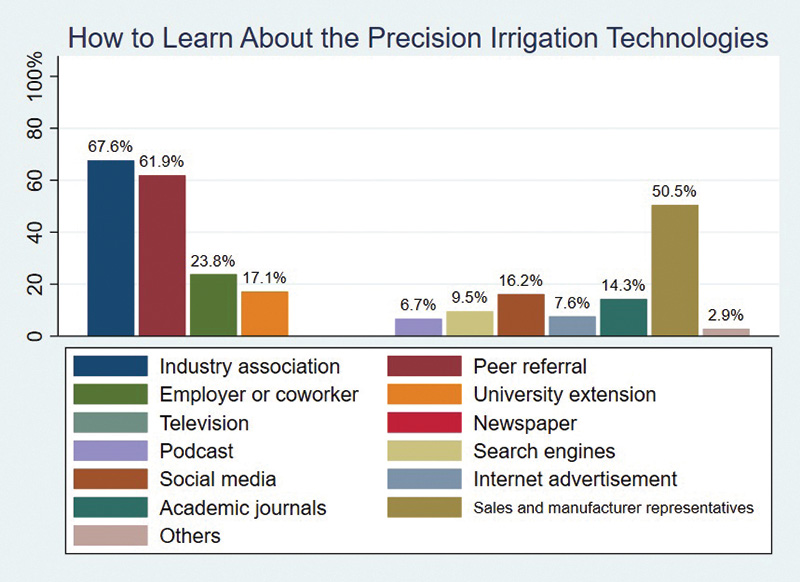
Figure 6. Information sources: how superintendents learn about precision irrigation technologies
The research says
- The top three driving forces for adopting precision irrigation technology are reducing water use, improving playability and enhancing turfgrass aesthetics.
- High initial costs present the most significant barrier to adopting precision irrigation technologies, both for first-time users and those looking to expand their use. Additionally, for many superintendents who have not yet adopted these technologies, the need for approval from higher-level administrators is a major hurdle.
- Information about precision irrigation technologies is primarily disseminated through industry-specific channels, with public platforms like social media and search engines being underutilized.
Acknowledgements
The authors wish to thank the Irrigation Innovation Consortium and the U.S. Golf Association for supporting our research. We appreciate all golf course superintendents who participated in our survey.
Literature cited
- Carlson, M.G., R.E. Gaussoin and L.A. Puntel. 2022. A review of precision management for golf course turfgrass. Crop, Forage & Turfgrass Management 8(2) (https://doi.org/10.1002/cft2.20183).
- Evans, R.G., S. Han, M.W. Kroeger and S.M. Schneider. 1996. Precision center pivot irrigation for efficient use of water and nitrogen. Proceedings of the Third International Conference on Precision Agriculture. 75-84. American Society of Agronomy, Inc. Crop Science Society of America Inc. Soil Science Society of America Inc.
- Gelernter, W.D., L.J. Stowell, M.E. Johnson, C.D. Brown and J.F. Beditz. 2015. Documenting trends in water use and conservation practices on U.S. golf courses. Crop, Forage & Turfgrass Management 1(1):1-10 (https://doi.org/10.2134/cftm2015.0149).
- Kehl, J. 2020. Moving beyond the mirage: Water scarcity and agricultural use inefficiency in USA. Water 12(8):2290 (https://doi.org/10.3390/w12082290).
- Lyman, G.T. 2012. How much water does golf use and where does it come from? United States Golf Association. (https://www.usga.org/content/dam/usga/pdf/Water%20Resource%20Center/how-much-water-does-golf-use.pdf).
- Sadler, E.J., R.G. Evans and C.R. Camp. 2005. Opportunities for conservation with precision irrigation. Journal of Soil and Water Conservation 60(6):371-378.
- Shaddox, T.W., J.B. Unruh, M.E. Johnson, C.D. Brown and G. Stacey. 2022. Water use and management practices on U.S. golf courses. Crop, Forage & Turfgrass Management 8(2) (https://doi.org/10.1002/cft2.20182).
- Straw, C.M., R.N. Carrow, W.J. Bowling, K.A. Tucker and G.M. Henry. 2018. Uniformity and spatial variability of soil moisture and irrigation distribution on natural turfgrass sports fields. Journal of Soil and Water Conservation 73(5):577-586 (https://doi.org/10.2489/jswc.73.5.577).
- Straw, C., C. Bolton, J. Young, R. Hejl, J. Friell and E. Watkins. 2022. Soil moisture variability on golf course fairways across the United States: An opportunity for water conservation with precision irrigation. Agrosystems, Geosciences & Environment 5(4) (https://doi.org/10.1002/agg2.20323).
- Wang, Y., C. Yue, E. Watkins and C. Straw. 2023. How do risk preferences affect golf course superintendents’ adoption of precision irrigation technologies? Implications from prospect theory. Journal of Agricultural and Applied Economics 55(3):516-535 (https://doi.org/10.1017/aae.2023.28).
- Wang, Y., C. Yue, E. Watkins and C. Straw. 2023. The driving forces and barriers of golf course superintendents’ adoption of precision irrigation technology. Journal of Environmental Horticulture 42(2):66-74 (https://doi.org/10.24266/0738-2898-42.2.66).
Chengyan Yue (yuechy@umn.edu) is the Bachman Endowed Chair in Horticultural Marketing and a professor in the Department of Horticultural Science and Department of Applied Economics at the University of Minnesota, St. Paul; Yang Wang is a doctoral student in the Department of Applied Economics at the University of Minnesota; Eric Watkins is a professor in the Department of Horticultural Science, University of Minnesota; and Chase Straw is an assistant professor in the Department of Soil and Crop Sciences, Texas A&M University, College Station.